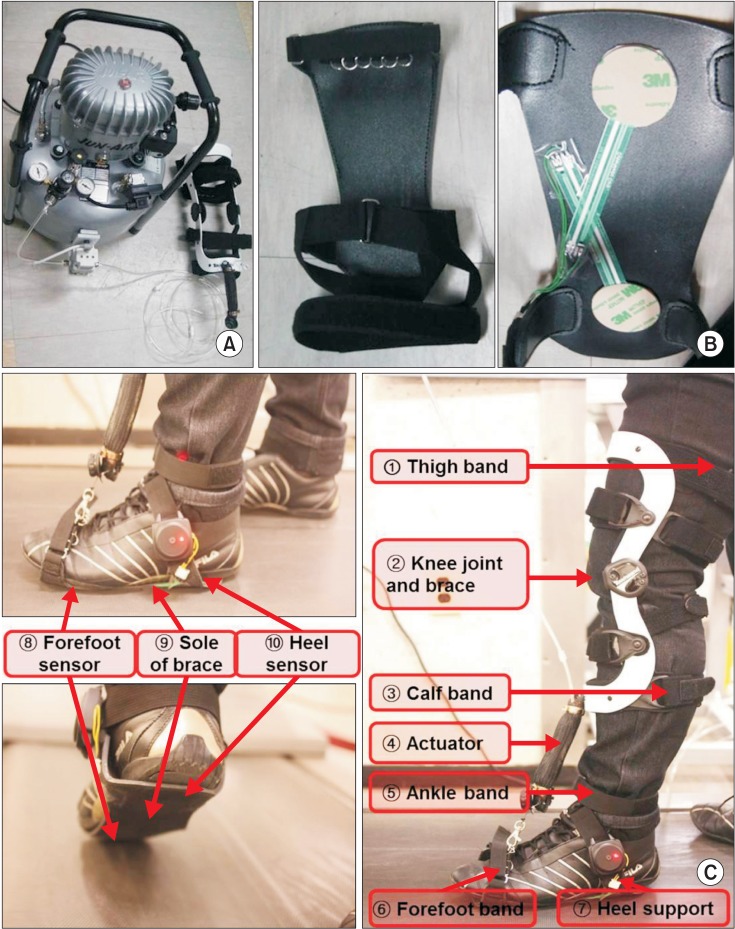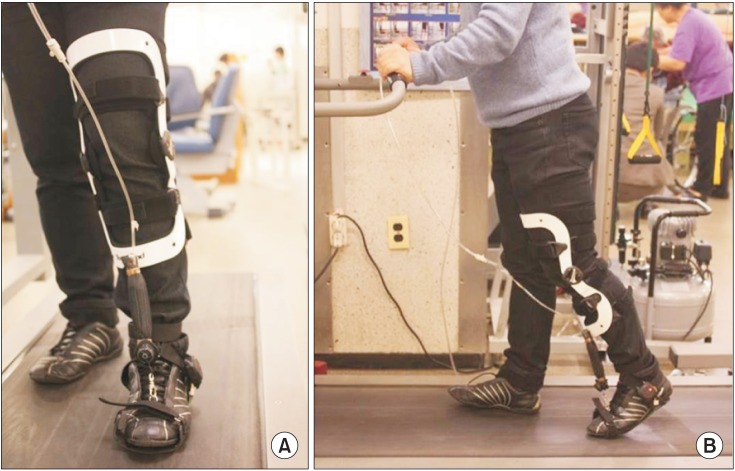Ann Rehabil Med.
2015 Apr;39(2):226-233. 10.5535/arm.2015.39.2.226.
Effect of Pneumatic Compressing Powered Orthosis in Stroke Patients: Preliminary Study
- Affiliations
-
- 1Department of Rehabilitation Medicine, Presbyterian Medical Center, Seonam University College of Medicine, Jeonju, Korea. gvcdr@hanmail.net
- 2Department of Rehabilitation Medicine, Chungnam University Hospital, Chungnam University School of Medicine, Daejeon, Korea.
- 3Christian Medical Research Center, Presbyterian Medical Center, Jeonju, Korea.
- KMID: 2273044
- DOI: http://doi.org/10.5535/arm.2015.39.2.226
Abstract
OBJECTIVE
To evaluate the feasibility and effectiveness of a knee-ankle-foot orthosis powered by artificial pneumatic muscles (PKAFO).
METHODS
Twenty-three hemiplegic patients (age, 59.6+/-13.7 years) were assessed 19.7+/-36.6 months after brain lesion. The 10-m walking time was measured as a gait parameter while the individual walked on a treadmill. Walking speed (m/s), step cycle (cycle/s), and step length (m) were also measured on a treadmill with and without PKAFO, and before and after gait training. Clinical parameters measured before and after gait training included Korean version of Modified Bathel Index (K-MBI), manual muscle test (MMT), and Modified Ashworth Scale (MAS) of hemiplegic ankle. Gait training comprised treadmill walking for 20 minutes, 5 days a week for 3 weeks at a comfortable speed.
RESULTS
The 10-m walking time, walking speed, step length, and step cycle were significantly greater with PKAFO than without PKAFO, and after gait training (both p<0.05). K-MBI was improved after gait training (p<0.05), but MMT and MAS were not.
CONCLUSION
PKAFO may improve gait function in hemiplegic patients. It can be a useful orthosis for gait training in hemiplegic patients.
Keyword
Figure
Reference
-
1. Fatone S, Gard SA, Malas BS. Effect of ankle-foot orthosis alignment and foot-plate length on the gait of adults with poststroke hemiplegia. Arch Phys Med Rehabil. 2009; 90:810–818. PMID: 19406301.
Article2. Fotopoulou A, Rudd A, Holmes P, Kopelman M. Self-observation reinstates motor awareness in anosognosia for hemiplegia. Neuropsychologia. 2009; 47:1256–1260. PMID: 19428388.
Article3. Kuan TS, Tsou JY, Su FC. Hemiplegic gait of stroke patients: the effect of using a cane. Arch Phys Med Rehabil. 1999; 80:777–784. PMID: 10414762.
Article4. Mauritz KH. Gait training in hemiplegia. Eur J Neurol. 2002; 9(Suppl 1):23–29. PMID: 11918646.
Article5. Embrey DG, Holtz SL, Alon G, Brandsma BA, McCoy SW. Functional electrical stimulation to dorsiflexors and plantar flexors during gait to improve walking in adults with chronic hemiplegia. Arch Phys Med Rehabil. 2010; 91:687–696. PMID: 20434604.
Article6. Ring H, Treger I, Gruendlinger L, Hausdorff JM. Neuroprosthesis for footdrop compared with an ankle-foot orthosis: effects on postural control during walking. J Stroke Cerebrovasc Dis. 2009; 18:41–47. PMID: 19110144.
Article7. Burridge JH, Wood DE, Taylor PN, McLellan DL. Indices to describe different muscle activation patterns, identified during treadmill walking, in people with spastic drop-foot. Med Eng Phys. 2001; 23:427–434. PMID: 11551819.
Article8. Kottink AI, Hermens HJ, Nene AV, Tenniglo MJ, van der Aa HE, Buschman HP, et al. A randomized controlled trial of an implantable 2-channel peroneal nerve stimulator on walking speed and activity in poststroke hemiplegia. Arch Phys Med Rehabil. 2007; 88:971–978. PMID: 17678657.
Article9. Simonsen EB, Moesby LM, Hansen LD, Comins J, Alkjaer T. Redistribution of joint moments during walking in patients with drop-foot. Clin Biomech (Bristol, Avon). 2010; 25:949–952.
Article10. Voigt M, Sinkjaer T. Kinematic and kinetic analysis of the walking pattern in hemiplegic patients with foot-drop using a peroneal nerve stimulator. Clin Biomech (Bristol, Avon). 2000; 15:340–351.
Article11. Abe H, Michimata A, Sugawara K, Sugaya N, Izumi S. Improving gait stability in stroke hemiplegic patients with a plastic ankle-foot orthosis. Tohoku J Exp Med. 2009; 218:193–199. PMID: 19561389.
Article12. Gatti MA, Freixes O, Fernandez SA, Rivas ME, Crespo M, Waldman SV, et al. Effects of ankle foot orthosis in stiff knee gait in adults with hemiplegia. J Biomech. 2012; 45:2658–2661. PMID: 22980576.
Article13. Nolan KJ, Savalia KK, Lequerica AH, Elovic EP. Objective assessment of functional ambulation in adults with hemiplegia using ankle foot orthotics after stroke. PM R. 2009; 1:524–529. PMID: 19627941.
Article14. Tyson SF, Kent RM. Effects of an ankle-foot orthosis on balance and walking after stroke: a systematic review and pooled meta-analysis. Arch Phys Med Rehabil. 2013; 94:1377–1385. PMID: 23416220.
Article15. Gok H, Kucukdeveci A, Altinkaynak H, Yavuzer G, Ergin S. Effects of ankle-foot orthoses on hemiparetic gait. Clin Rehabil. 2003; 17:137–139. PMID: 12625653.
Article16. Yamamoto S, Hagiwara A, Mizobe T, Yokoyama O, Yasui T. Development of an ankle-foot orthosis with an oil damper. Prosthet Orthot Int. 2005; 29:209–219. PMID: 16466151.17. Kao PC, Ferris DP. Motor adaptation during dorsiflexion-assisted walking with a powered orthosis. Gait Posture. 2009; 29:230–236. PMID: 18838269.
Article18. Cain SM, Gordon KE, Ferris DP. Locomotor adaptation to a powered ankle-foot orthosis depends on control method. J Neuroeng Rehabil. 2007; 4:48. PMID: 18154649.
Article19. Gordon KE, Sawicki GS, Ferris DP. Mechanical performance of artificial pneumatic muscles to power an ankle-foot orthosis. J Biomech. 2006; 39:1832–1841. PMID: 16023126.
Article20. Milovanovic I, Popovic DB. Principal component analysis of gait kinematics data in acute and chronic stroke patients. Comput Math Methods Med. 2012; 2012:649743. PMID: 22400054.21. Roth EJ, Merbitz C, Mroczek K, Dugan SA, Suh WW. Hemiplegic gait. Relationships between walking speed and other temporal parameters. Am J Phys Med Rehabil. 1997; 76:128–133. PMID: 9129519.22. Ng SS, Hui-Chan CW. Contribution of ankle dorsiflexor strength to walking endurance in people with spastic hemiplegia after stroke. Arch Phys Med Rehabil. 2012; 93:1046–1051. PMID: 22440486.
Article23. Liberson WT, Holmquest HJ, Scot D, Dow M. Functional electrotherapy: stimulation of the peroneal nerve synchronized with the swing phase of the gait of hemiplegic patients. Arch Phys Med Rehabil. 1961; 42:101–105. PMID: 13761879.24. Taylor PN, Burridge JH, Dunkerley AL, Lamb A, Wood DE, Norton JA, et al. Patients' perceptions of the Odstock Dropped Foot Stimulator (ODFS). Clin Rehabil. 1999; 13:439–446. PMID: 10498351.
Article25. Kluding PM, Dunning K, O'Dell MW, Wu SS, Ginosian J, Feld J, et al. Foot drop stimulation versus ankle foot orthosis after stroke: 30-week outcomes. Stroke. 2013; 44:1660–1669. PMID: 23640829.26. Mulroy SJ, Eberly VJ, Gronely JK, Weiss W, Newsam CJ. Effect of AFO design on walking after stroke: impact of ankle plantar flexion contracture. Prosthet Orthot Int. 2010; 34:277–292. PMID: 20738232.27. Ferris DP, Gordon KE, Sawicki GS, Peethambaran A. An improved powered ankle-foot orthosis using proportional myoelectric control. Gait Posture. 2006; 23:425–428. PMID: 16098749.
Article28. Sawicki GS, Domingo A, Ferris DP. The effects of powered ankle-foot orthoses on joint kinematics and muscle activation during walking in individuals with incomplete spinal cord injury. J Neuroeng Rehabil. 2006; 3:3. PMID: 16504172.
Article29. Bulley C, Shiels J, Wilkie K, Salisbury L. User experiences, preferences and choices relating to functional electrical stimulation and ankle foot orthoses for foot-drop after stroke. Physiotherapy. 2011; 97:226–233. PMID: 21820541.
Article30. Janssen WG, Bussmann HB, Stam HJ. Determinants of the sit-to-stand movement: a review. Phys Ther. 2002; 82:866–879. PMID: 12201801.
Article31. Dogan A, Mengulluoglu M, Ozgirgin N. Evaluation of the effect of ankle-foot orthosis use on balance and mobility in hemiparetic stroke patients. Disabil Rehabil. 2011; 33:1433–1439. PMID: 21091133.32. Wall JC, Turnbull GI. Gait asymmetries in residual hemiplegia. Arch Phys Med Rehabil. 1986; 67:550–553. PMID: 3741082.
- Full Text Links
- Actions
-
Cited
- CITED
-
- Close
- Share
- Similar articles
-
- Status of Using Lower Extremity Orthoses in Patients with Chronic Stroke and Traumatic Brain Injury
- The Prospectives on The Association between Disability Resulted from Hansen's Disease and Orthosis Prescribed to Patients with Hansen's Disease
- The Early Usage Pattern of Spinal Orthosis in Patients with Spinal Metastasis
- The Effects of Plastic Ankle-foot Orthosis on Elderly Stroke Patients
- Effects of Ankle Foot Orthosis on Post-stroke Hemiplegic Gait -A Meta-analysis-



